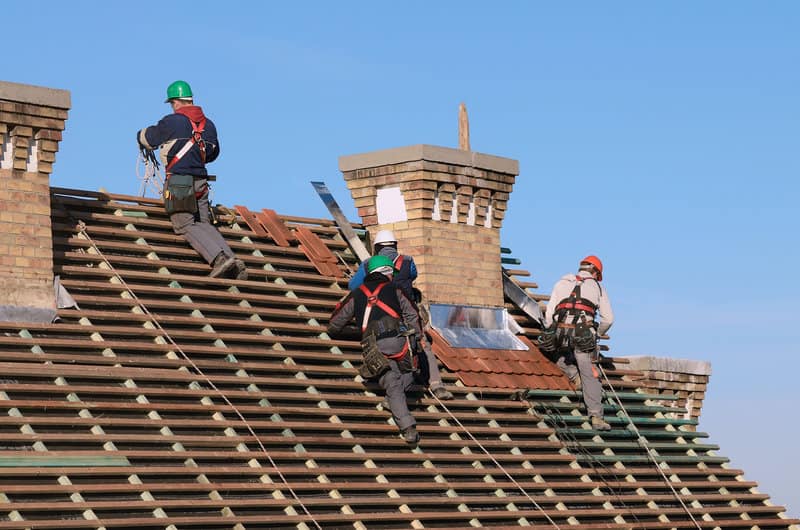A skilled Roofing Contractor can provide top-tier roof installations and repairs.
A skilled Roofing Contractor can provide top-tier roof installations and repairs.
Blog Article
How to Assess Various Roofing Options for Your Building Needs
Assessing roofing alternatives for your structure calls for a thorough approach that considers various factors such as the meant use of the structure, local climate problems, and material features. It is important to weigh the benefits and disadvantages of various roofing kinds, from asphalt tiles to metal and clay tiles, while also considering preliminary expenses and lasting maintenance. Additionally, understanding power performance and aesthetic appeal can affect your choice. As you contemplate these considerations, one inquiry stays: which factors will inevitably direct your selection for a sustainable and aesthetically pleasing roof covering service?
Evaluating Your Building's Needs
To properly evaluate roof alternatives, start by completely analyzing your building's needs. Beginning by taking into consideration the structure's intended usage, as various frameworks might demand differing roofing requirements. Domestic roofing systems typically prioritize appearances and insulation, while commercial structures may concentrate on toughness and load-bearing capability.
Following, examine the local climate problems that will affect roofing efficiency. Factors such as temperature level fluctuations, precipitation levels, and wind patterns can influence product selection and layout. A roof that masters a warm climate may not do also in areas susceptible to hefty snowfall or extreme warmth.
Furthermore, analyze the structural integrity of your structure. Make sure that the existing framework can support the chosen roof covering materials, particularly if thinking about larger choices. It is likewise important to review any type of local building ordinance or guidelines that may determine specific demands for roofing systems.

Contrasting Roof Covering Products
Once an extensive analysis of your building's needs has actually been finished, the next step involves contrasting numerous roof covering products. Each product provides unique benefits and negative aspects, making it necessary to align your option with your particular requirements and situations.
Asphalt shingles are widely identified for their cost and simplicity of setup, making them a preferred option for residential buildings. On the other hand, metal roof covering, recognized for its sturdiness and durability, can endure severe weather yet may feature a greater initial financial investment.
Clay and concrete floor tiles supply outstanding thermal insulation and aesthetic allure, especially for Mediterranean-style design, yet they require an even more robust architectural support as a result of their weight. Timber trembles offer an all-natural look and excellent insulation residential or commercial properties yet might demand a lot more maintenance and are at risk to fire risks.
Assessing Price and Budget
Examining your roofing alternatives necessitates a mindful analysis of expense and spending plan considerations. The total budget for a roof covering project makes up have a peek here numerous elements, consisting of material prices, labor expenses, upkeep, and possible long-term savings. It is important to establish a clear budget plan before discovering details roof covering materials, as this will guide the decision-making procedure and aid you avoid overspending.
Begin by obtaining quotes from several specialists to understand labor prices in your area. Make certain that these estimates include all needed services, such as removal of the old roof covering, installation, and any extra functions, like insulation or air flow enhancements - Roofer. Next, examine the price of numerous roofing products, taking into consideration both preliminary setup expenses and expected life-span

Comprehending Power Efficiency
Energy performance plays a crucial function in the selection of roof covering products and systems, significantly affecting both power intake and general comfort within a structure. A well-chosen roof covering can improve thermal efficiency, decreasing the demand for heating and cooling systems, which consequently decreases energy bills and decreases environmental effect.
When reviewing roof covering choices, take into consideration products that reflect as opposed to take in warmth. Light or reflective roofing items can considerably lower roofing surface temperatures, resulting in lower energy usage throughout warm months. Furthermore, appropriate insulation and ventilation are necessary to maximize the power performance of the entire roof. Insulation stops warm transfer, while ventilation reduces heat accumulation in the attic area.
Another vital aspect is the roof's longevity and upkeep demands. Durable materials that require less constant substitute add to lasting power savings. The energy performance of a roofing system can also be examined through its compliance with well-known sustainability scores such as Power STAR or LEED.
Thinking About Visual Allure
A roof covering's aesthetic charm significantly affects the total appearance of a building, enhancing its building style and improving aesthetic appeal. Perrysburg Roofer. When assessing roof covering choices, it is important to consider exactly how the chosen product, color, and layout will integrate with the existing framework and area. A well-designed roofing can elevate even the easiest of structures, changing them into aesthetic focal factors
Different roof covering materials provide numerous aesthetic qualities. As an example, typical shingles may evoke a timeless charm, while metal roofing go to these guys can pass on a modern-day, smooth look. In addition, the color of the roof product plays an essential role; lighter tones can make a building appear more spacious, while darker tones might create a cozier setting.
Furthermore, building elements, such as dormers and eaves, can boost the roof's aesthetic impact. It is recommended to speak with professional developers or engineers to ensure the chosen roof alternative lines up with the total layout intent. Eventually, a roofing system needs to not just offer functional benefits yet also add favorably to the structure's visual, showing the proprietor's preference and the character of the surrounding atmosphere.
Verdict

Report this page